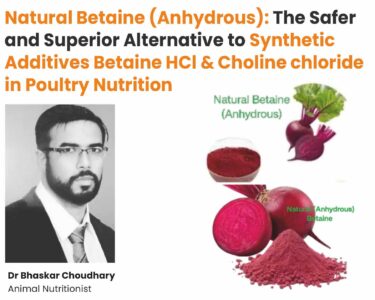Elevating Poultry Productivity: Innovative Approaches to Feeding Strategies

Dr. Sundus Gazal1, Dr. Sabahat Gazal2, Dr. Anvesha Bhan3 and Dr. Shalini Pandey4
1,2,3Division of Veterinary Microbiology and Immunology, SKUAST-Jammu
4Department of Veterinary Microbiology, RPS Veterinary College, Mahendragarh

Introduction:
Poultry farming is an integral part of the global food supply chain, meeting the demand for protein-rich meat and eggs. Achieving optimal growth, health, and productivity in poultry operations is essential for farmers to meet market demands and ensure profitability. A critical factor in achieving these goals lies in implementing effective feeding strategies. In this article, we will explore in-depth the various facets of poultry feeding that can lead to increased productivity, streamlined operations, and improved economic outcomes.
Nutrient Balance:
At the core of successful poultry feeding is providing a balanced and nutritionally rich diet as poultry convert feed into food products quickly, efficiently, and with relatively low environmental impact relative to other livestock. Their high rate of productivity results in relatively high nutrient needs. Poultry require a complex combination of nutrients including proteins, carbohydrates, fats, vitamins, and minerals for their growth and well-being. Feed ingredients for poultry diets are selected for the nutrients they can provide, the absence of anti-nutritional or toxic factors, their palatability or effect on voluntary feed intake, and their cost. Poultry require at least 38 nutrients in their diets in appropriate concentrations and balance. These nutritional requirements evolve as birds progress from chicks to mature individuals, necessitating careful adjustment of feed formulations at different growth stages depending on the requirements related to production (e.g., growth, feed efficiency, egg production), prevention of deficiency symptoms, and quality of poultry products.
Feed Formulation:
Feed formulation involves quantification of the amount of feed ingredients required to be combined to form a single uniform balanced diet for poultry which can supply all the nutritional requirements of the birds. Since feed accounts for 65-75% of total live production costs for most types of poultry throughout the world, a simple mistake in diet formulation can be extremely expensive for a poultry producer. It requires a thorough understanding of the nutrient requirements of the class of poultry (e.g., egg layers, meat chickens or breeders); feed ingredients in terms of nutrient composition and constraints in terms of nutrition and processing; and cost and availability of the ingredients. The quality of feed directly impacts the health and growth of poultry. Opting for high-quality ingredients ensures that the feed is easily digestible and minimizes wastage. In addition to energy and protein, the formulations should also contain supplements to provide minerals, vitamins and specific amino acids.
These supplements must be added to all diets as they provide essential nutrients necessary for health and performance. Modern feed formulations also contain a diverse range of non-nutritive additives, which may not be essential but have an important bearing on performance and health. A major factor to be considered in selecting these additives is their efficacy as they are used in only small quantities, which makes it particularly important that they are mixed carefully with the main ingredients so that they are evenly distributed. Beyond ingredient selection, the form of feed also matters. Pelleted or crumbled feeds have been shown to enhance feed efficiency, minimize waste, and improve nutrient absorption. There are several systems of feeding: free-choice or “cafeteria style” feeding of mash and grain, controlled feeding of mash and grain, feeding all mash, or other combinations of a complete feed. Each system should accommodate the specific needs of the flock, and be designed for flexibility, low maintenance, and reliability to keep installation and operating costs low. The choice of one of these feeding systems will depend mainly upon the size of the flock and the labour and equipment available.
Incorporating feed additives further supports digestive health and nutrient utilization. These additives are primarily included to improve the efficiency of the bird’s growth and/or laying capacity, prevent disease and improve feed utilisation. Common feed additives used in poultry diets include probiotics, prebiotics, antimicrobials, antioxidants, emulsifiers, binders, pH control agents, enzymes, flavour enhancers, artificial and nutritive sweeteners, colours, lubricants, etc. Modern intensive poultry production has achieved phenomenal gains in the efficient and economical production of high quality and safe chicken meat, eggs and poultry bioproducts by the use of properly balanced high quality feed and feed additives.
Feeding Programs:
Developing a structured feeding schedule is a cornerstone of effective poultry management. Birds of different ages have distinct nutritional requirements. Therefore, a well-designed feeding program must align with the specific age and purpose of the poultry – whether they are being raised for meat or egg production. Gradual transitions between feed formulations during growth phases prevent digestive disturbances and ensure a smooth progression from one growth stage to another.
Water Management:
Water is a critical, but often overlooked, nutrient. Uninterrupted access to clean and fresh water is a fundamental aspect of poultry health and growth. Adequate hydration plays a pivotal role in determining feed intake and metabolic processes. A consistent supply of clean water supports efficient nutrient absorption, aids in digestion, and contributes to the overall well-being of the birds. Effective water management complements the feeding strategy and maximizes its impact.
Feeding Space and Equipment:
Creating an environment that minimizes stress during feeding times is crucial. Sufficient feeding space is essential to prevent competition and aggression among birds, ensuring equitable access to feed. Without a good feed distribution and sufficient feeder space the smaller or less aggressive birds will not get their share of the available daily feed amount, and uniformity will suffer. Employing appropriate feeding equipment that minimizes wastage while facilitating easy access to feed enhances consumption efficiency and reduces unnecessary costs. A good feeder should be durable enough to withstand frequent cleaning; stable enough not to be knocked over; of the correct height and depth; bird proof (such that birds cannot get into it or roost in it); and equipped with a lip to prevent birds from spooning feed out onto the floor with their beaks. The height of the feed inside the feeder, which should never be more than one-third full, should be level with the back of the birds, to prevent them from scratching contaminated litter into the feeders and to limit feed wastage.
Feeders can be made of wood, sheet metal or bamboo, and are best suspended from the roof to keep rats out.
Natural Foraging and Enrichment:
Encouraging natural behaviors among poultry is vital for their welfare and productivity. Allowing outdoor access or enriching the indoor environment with opportunities for foraging, pecking, and exploration engages the birds both physically and mentally. Environmental enrichment strategies are used to help prevent boredom and improves the physical and mental wellbeing of the flock. It helps reduce bullying amongst flock members, improves mental and physical health, and decreases the likelihood of injuries. Enrichment strategies are aimed at increasing opportunities for the animals to engage in natural behaviours that they would normally do in the wild. The five different forms of enrichment include cognitive, foraging (food), social, sensory, and environmental. This engagement reduces stress levels and enhances overall health, translating into improved productivity.
Monitoring and Record Keeping: Record keeping involves taking notes about what happens on the farm and involves information with regards to feed, water, medicine, and other items used on the farm. It also includes documenting any problems or events that happen on the farm and includes regular assessment of the growth and well-being of the flock. Maintaining accurate records of key metrics such as feed consumption, weight gain, and mortality rates provides valuable insights into the success of the chosen approach. This data-driven approach empowers farmers to make informed adjustments and continuously refine their feeding strategy. Records tell a manager where the business/operation has been and the direction in which it is going. Records show the strength and weaknesses of the poultry operation. They provide useful insight to financial stability for the flock. If there are any shortcomings, records will show where adjustments can be made.

Health and Biosecurity:
A robust health management strategy is pivotal in ensuring optimal feed intake and growth. A poultry operation’s success or failure can be dramatically affected by biosecurity, which is the effective use of standard hygienic practices. Biosecurity comprises of the Structural biosecurity which includes all facets pertaining to facilities and equipment; and Operational biosecurity which refers to normal tasks carried out on a farm on a regular basis, such as staff entry, vehicle entry and disinfection, pest management, garbage disposal, etc. Stringent biosecurity measures help prevent the introduction and spread of diseases that can disrupt feed consumption and growth rates. Regular veterinary supervision is essential to monitor flock health, identify potential issues, and recommend appropriate interventions. A strong health foundation lays the groundwork for the effectiveness of the feeding strategy.
Adaptation and Innovation:
The field of poultry nutrition is dynamic, with new technologies and methodologies constantly emerging. Poultry farmers must stay informed about advancements and be willing to embrace innovative practices. Artificial intelligence is a powerful tool that could help poultry produces improve efficiency and address welfare and health challenges. This technology has many possible applications for poultry operations. Examples include machine learning, camera vision and acoustic monitoring to improve bird welfare and share data with veterinarians. Automation can be used to replace manual labor on poultry farms when it comes to repetitive tasks like checking bird welfare, removing welfare, vaccinations and managing litter. In addition to this, precision feeding, automated systems, and data analytics are examples of innovations that can fine-tune feed efficiency, reduce costs, and amplify overall productivity.
Economic Considerations:
Profitability is a central concern for poultry farmers. Feed is the major component of input cost, accounting for up to 70% of the total production cost. Effective feeding strategies strike a balance between input costs and output gains. Conducting comprehensive cost-benefit analyses empowers farmers to make informed decisions regarding feed formulations, feed conversion ratios (FCR), and other critical factors that directly influence the financial bottom line.
Conclusion:
Implementing a thoughtfully designed feeding strategy is the linchpin of successful poultry farming. By focusing on nutrient balance, feed formulation, feeding schedules, and other key elements, poultry farmers can elevate the productivity and profitability of their operations. Continuous monitoring, adaptability to new techniques, and unwavering commitment to bird health are instrumental in ensuring long-term success in the ever-evolving realm of poultry farming. Through these efforts, poultry farmers not only meet the global demand for food but also uphold the well-being of their flocks and the sustainability of their operations.






